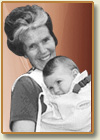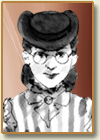COBOL
The achievements of Admiral Grace Murray Hopper which, most notably, include the invention of the compiler, cemented her place at the forefront of the computing revolution that began in the early 1940s. Trained as a mathematician, her career spanned six decades during which she remained simultaneously connected across several disciplines and industries, including academia, industry and the U.S. military.

Born Grace Brewster Murray on December 9, 1906 in New York City, she was the eldest of three children, and shared with her mother an affinity for mathematics.
She attended Vassar College, from where she graduated in 1928, Phi Beta Kappa, with a BA in mathematics and physics. She took on a teaching post there while she pursued graduate studies at Yale University, completing MA and PhD degrees in mathematics at Yale in 1930 and 1934, respectively.
Meanwhile, in 1930, she married Vincent Foster Hopper, an English instructor with the New York School of Commerce, whom she divorced several years later. She continued to teach at Vassar, achieving the rank of associate professor in 1941, when she was awarded a fellowship at New York University's Courant Institute for Mathematics.
Hopper made a life-altering decision in 1943 when she decided to join the World War II effort and enlist with Navy WAVES, for Women Accepted for Voluntary Emergency Service, in December of that year. Her family had strong military ties, thus this was not a totally unexpected move for Hopper; however, it presented her with extraordinary opportunities to contribute to the early development of computing machines. In July 1944, having been commissioned a lieutenant, she became part of the team working on the Bureau of Ordnance Computation Project at Harvard University, along with professor and Naval Reserve officer Howard H. Aiken.
Aiken was the principal engineer behind IBM's Harvard Mark I computer, considered the first large-scale automatic digital computer in the United States.
As the third person to have the opportunity to work on this machine, Hopper dove in and learned to program it, in the process authoring a 500-page manual of operations that would serve to lay down lasting principles for computer operation. She went on to work with the Mark II and III machines and was later recognized for her achievements with a Naval Ordnance Development Award.
In 1946 she returned to inactive duty and joined the Harvard faculty as a research fellow, where she continued her computing research until 1949.
That year she accepted a post as senior mathematician with Eckert-Mauchly Computer, which was purchased in 1950 by Remington Rand and merged into the Sperry Corporation in 1955. During this period, Hopper developed the revolutionary concept of the compiler, an intermediate program that translates instructions written in English into code that may be understood by the computer. Normally, programmers would have to write programs out in binary code, consisting of long series of zeros and ones. A compiler would allow a programmer to compose code more quickly and easily, without as much room for error, using English commands.
Hopper's first compiler, A-O, was unveiled in 1949, and used symbolic mathematical code to represent binary code combinations. This she followed up with B-O, or "Flow-Matic," considered the first English language data-processing compiler. This was used to program UNIVAC I and II machines by the end of 1956.
The UNIVAC, which stands for Universal Automatic Computer, was among the first commercially available computers in the Unites States, built by Sperry Rand.
When discussions arose as to how to create a standardized, universal computer language, Hopper was deeply involved in the development of COBOL; her Flow-Matic compiler was used to help form a basis for the language, and she designed standard manuals and tools for it as well as translator programs that converted non-standard COBOL languages into the standard version. The first specifications for COBOL were made available in 1959.
Hopper retired from the Naval Reserves in 1966; however, in 1967 she took military leave from Sperry when she was called back into active duty to help the Navy standardize high-level computing languages. Her service was extended indefinitely, and she officially retired from Sperry in 1971.
For the Navy, Hopper worked on high-level computing research and development, including formula translation, code optimization and subroutines. She also educated thousands of people on the use of compilers and computer language standardization via speaking engagements throughout the world. In 1983 she was promoted to commodore at a ceremony that took place at the White House in Washington, D.C. She became Admiral Hopper in 1985 when this post was merged with rear admiral. She retired from the Navy in 1986.
Hopper then became a senior consultant to Digital Equipment Corporation, where she worked well into her 80s.
She was awarded a National Medal of Technology in 1991, and was honored with more than 40 honorary doctoral degrees, as well as the first ever Computer Science Man-of-the-Year Award from the Data Processing Management Association in 1969. A U.S. warship was also named in her honor. In 1973, she became the first person from the United States, and the first woman from any nation, to become a Distinguished Fellow of the British Computer Society.
Hopper died on January 1, 1992, and was buried with full military honors in Arlington National Cemetery.












 For many women inventors in years past, the invention process was twice as difficult because, in addition to the hardships of inventing, they also faced the skepticism of a world that didn't believe women could create something of value. Fortunately, over the years, that perception has been blown out of the water by women inventors like Margaret E. Knight, who were willing to fight for the accolades and recognition they unquestionably deserved.
For many women inventors in years past, the invention process was twice as difficult because, in addition to the hardships of inventing, they also faced the skepticism of a world that didn't believe women could create something of value. Fortunately, over the years, that perception has been blown out of the water by women inventors like Margaret E. Knight, who were willing to fight for the accolades and recognition they unquestionably deserved.

 Born Grace Brewster Murray on December 9, 1906 in New York City, she was the eldest of three children, and shared with her mother an affinity for mathematics. She attended Vassar College, from where she graduated in 1928, Phi Beta Kappa, with a BA in mathematics and physics. She took on a teaching post there while she pursued graduate studies at Yale University, completing MA and PhD degrees in mathematics at Yale in 1930 and 1934, respectively.
Born Grace Brewster Murray on December 9, 1906 in New York City, she was the eldest of three children, and shared with her mother an affinity for mathematics. She attended Vassar College, from where she graduated in 1928, Phi Beta Kappa, with a BA in mathematics and physics. She took on a teaching post there while she pursued graduate studies at Yale University, completing MA and PhD degrees in mathematics at Yale in 1930 and 1934, respectively. 

